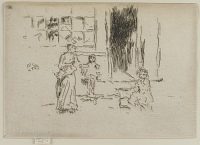Petticoat Lane | ||
| Number: | 299 | |
| Date: | 1887 | |
| Medium: | etching and drypoint | |
| Size: | 95 x 134 mm | |
| Signed: | butterfly at left | |
| Inscribed: | no | |
| Set/Publication: | no | |
| No. of States: | 2 | |
| Known impressions: | 8 | |
| Catalogues: | K.285; M.281; W.230 | |
| Impressions taken from this plate (8) | ||
KEYWORD
streetscape, children, shop, woman standing.
TITLE
It has always had a site specific title, as in the following examples:
'Petticoat Lane' (1887/1888, Whistler). 2
'Petticoat Lane No. 1' (1888, Wunderlich's). 3
'Petticoat Lane' (1899, Frederick Wedmore (1844-1921)). 4
'Petticoat Lane' is therefore the generally accepted title.
'Petticoat Lane' (1887/1888, Whistler). 2
'Petticoat Lane No. 1' (1888, Wunderlich's). 3
'Petticoat Lane' (1899, Frederick Wedmore (1844-1921)). 4
'Petticoat Lane' is therefore the generally accepted title.
DESCRIPTION
A view across a street: at upper left is a window and to right a dark, open doorway. The many panes of the window are full of miscellaneous goods, roughly indicated against the shadows of the interior and reflections on the glass. A woman is standing in the lane in front of the window, with her face turned to the right, holding a basket or bundle of goods. To right of her, on the pavement, stands a child, and further right, at the edge of the pavement, sits a girl with ribbons or a bonnet on her hair. Between them, on the lane, there is a box or heap, possibly of goods for sale.
SITE
Petticoat Lane in the East End of London was and still is a busy garment and textile market, with textiles from all over the world selling on hundreds of stalls. Petticoat Lane (also known as Middlesex Street) was the site of a very busy Sunday market, dominated by Jewish traders. This was a poor neighbourhood teeming with poor workers and immigrants, gamblers and street-hawkers, and criminals (a year later it was close to the site of the Whitechapel murders). 5 However, Whistler shows a tiny fragment of the scene, with a shop window and possibly more goods displayed on the ground. It is a very small scale operation - a representation of street life.
5: See The Times, London, 12 July 1888, p. 3 on the conduct of the market, and 1 October 1888, p. 6, on the East End murders.
Nearby Whistler etched Clothes-Exchange, Houndsditch. No. 1 358, Clothes-Exchange, Houndsditch. No. 2 359, Fleur-de-lis Passage 360, Cutler Street, Houndsditch 361 and After the Sale, Clothes Exchange, Houndsditch 357.
Whistler did not see Petticoat Lane as a good influence on dress: in the 'Ten o'Clock' Lecture in 1885 he urged women to reject certain trends in fashion:
'What! will you come up and follow the first piper that leads you down Petticoat Lane, there, on a Sabbath, to gather, for the week, from the dull rags of Ages, wherewith to bedeck yourselves! - that beneath your travestied awkwardness, we have trouble to find your own dainty selves! Oh fi! - Is the world then exhausted! - and must we go back, because the thumb of the mountebank jerks the other way? -
Costume is not dress -
and the wearers of wardrobes may not be doctors of 'taste'! - For by what authority shall these be pretty masters! - Look well, and nothing have they invented! - nothing put together for comeliness' sake -
Haphazard from their shoulders hang the garments of the Hawker - combining in their person, the motley of many manners, with the medley of the mummers' closet -
Set up as a warning, and a fingerpost of danger - they point to the disastrous effect of Art upon the Middle Classes - ' 6
Costume is not dress -
and the wearers of wardrobes may not be doctors of 'taste'! - For by what authority shall these be pretty masters! - Look well, and nothing have they invented! - nothing put together for comeliness' sake -
Haphazard from their shoulders hang the garments of the Hawker - combining in their person, the motley of many manners, with the medley of the mummers' closet -
Set up as a warning, and a fingerpost of danger - they point to the disastrous effect of Art upon the Middle Classes - ' 6
DISCUSSION
Wedmore called the subject 'a squalid doorway', possibly because children appear to be sitting and standing on the pavement in front of the doorway - there is nothing intrinsically squalid about the door or figures. 7
7: Wedmore 1886 A[more] (cat. no. 230).
